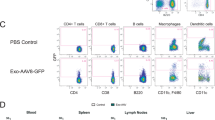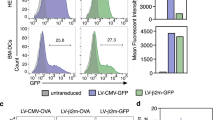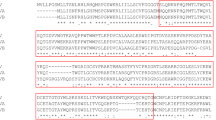Abstract
The potential of adeno-associated virus (AAV)-based vectors in human gene therapy is being explored for several diseases. Although sustained transgene expression and low vector-associated cellular immunity are attractive features of recombinant (r) AAV, the wider application of rAAV vectors encapsidated in serotype 2 capsid is hampered by poor transduction efficiency in many target tissues. These include ex vivo-generated dendritic cells (DC), which have demonstrated promising immunotherapeutic activity. We report here that efficient transduction of mouse bone marrow-derived DC can be achieved with self-complementary (sc) rAAV encapsidated in serotype 6 capsid. Sequential exposure of DC precursor cultures to IL-4 and GM-CSF with sc rAAV6 encoding the human tumor antigen, carcinoembryonic antigen (CEA), for 7 days followed by activation with CpG oligodeoxynucleotides (ODN) and anti-mouse CD40 antibody resulted in highly efficient transduction of DC. DC surface markers as determined by flow cytometry analysis of sc rAAV6-transduced DC were comparable to nontransduced DC. Efficiency of vector transduction and transgene expression were confirmed by immunostaining and real-time PCR. Microarray analysis of RNA from CpG ODN and CD40 antibody stimulated sc AAV6-transduced DC revealed upregulation of transcription factors and cytokines involved in immune activation and downregulation of inhibitory factors, suggesting a possible role of transcriptional activation in the observed effect. The adoptive transfer into syngeneic mice of the ex vivo-transduced and activated DC resulted in the development of CEA-specific antibody and T-helper 1-associated immune responses. Immunized mice also developed antibody to AAV6 capsid protein, which did not crossreact with AAV2 capsid protein. These studies demonstrate the potential utility of sc rAAV serotype 6-based vectors in transduction of DC for genetic vaccination approaches.
This is a preview of subscription content, access via your institution
Access options
Subscribe to this journal
Receive 12 print issues and online access
$259.00 per year
only $21.58 per issue
Buy this article
- Purchase on Springer Link
- Instant access to full article PDF
Prices may be subject to local taxes which are calculated during checkout









Similar content being viewed by others
References
Buning H, Nicklin SA, Perabo L, Hallek M, Baker AH . AAV-based gene transfer. Curr Opin Mol Ther 2003; 5: 367–375.
Flotte TR . Gene therapy progress and prospects: recombinant adeno-associated virus (rAAV) vectors. Gene Therapy 2004; 11: 805–810.
Stilwell JL, Samulski RJ . Adeno-associated virus vectors for therapeutic gene transfer. Biotechniques 2003; 34: 148–150.
Flotte TR, Brantly ML, Spencer LT, Byrne BJ, Spencer CT, Baker DJ et al. Phase I trial of intramuscular injection of a recombinant adeno-associated virus alpha 1-antitrypsin (rAAV2-CB-hAAT) gene vector to AAT-deficient adults. Hum Gene Ther 2004; 15: 93–128.
Kay MA, Manno CS, Ragni MV, Larson PJ, Couto LB, McClelland A et al. Evidence for gene transfer and expression of factor IX in haemophilia B patients treated with an AAV vector. Nat Genet 2000; 24: 257–261.
Moss RB, Rodman D, Spencer LT, Aitken ML, Zeitlin PL, Waltz D et al. Repeated adeno-associated virus serotype 2 aerosol-mediated cystic fibrosis transmembrane regulator gene transfer to the lungs of patients with cystic fibrosis: a multicenter, double-blind, placebo-controlled trial. Chest 2004; 125: 509–521.
Haigwood NL, Montefiori DC, Sutton WF, McClure J, Watson AJ, Voss G et al. Passive immunotherapy in simian immunodeficiency virus-infected macaques accelerates the development of neutralizing antibodies. J Virol 2004; 78: 5983–5995.
Johnson PR, Schnepp BC, Connell MJ, Rohne D, Robinson S, Krivulka GR et al. Novel adeno-associated virus vector vaccine restricts replication of simian immunodeficiency virus in macaques. J Virol 2005; 79: 955–965.
Ponnazhagan S . Adeno-associated virus vectors for genetic immunization. J Immunol Res 2002; 26: 247–253.
Ponnazhagan S, Mahendra G, Lima J, Aldrich WA, Jenkins CB, Ren C et al. Augmentation of anti-tumor activity of a recombinant adeno-associated virus carcinoembryonic antigen vaccine with plasmid adjuvants. Hum Gene Ther 2004; 15: 856–864.
Banchereau J, Steinman RM . Dendritic cells and the control of the immunity. Nature 1998; 392: 245–252.
Ponnazhagan S, Mahendra G, Curiel DT, Shaw DR . Adeno-associated virus-mediated transduction of human monocyte-derived dendritic cells: implications for ex vivo immunotherapy. J Virol 2001; 75: 9493–9501.
Figdor CG, de Vries IJ, Lesterhuis WJ, Melief CJ . Dendritic cell immunotherapy: mapping the way. Nat Med 2004; 10: 475–480.
Jooss K, Yang Y, Fisher KJ, Wilson JM . Transduction of dendritic cells by DNA viral vectors directs the immune response to transgene products in muscle fibers. J Virol 1998; 72: 4212–4223.
Xiao W, Chirmule N, Schnell MA, Tazelaar J, Hughes JV, Wilson JM . Route of administration determines induction of T-cell-independent humoral responses to adeno-associated virus vectors. Mol Ther 2000; 1: 323–329.
Burger C, Gorbatyuk OS, Velardo MJ, Peden CS, Williams P, Zolotukhin S et al. Recombinant AAV viral vectors pseudotyped with viral capsids from serotypes 1, 2, and 5 display differential efficiency and cell tropism after delivery to different regions of the central nervous system. Mol Ther 2004; 10: 302–317.
Halbert CL, Rutledge EA, Allen JM, Russell DW, Miller AD . Repeat transduction in the mouse lung by using adeno-associated virus vectors with different serotypes. J Virol 2000; 74: 1524–1532.
Louboutin JP, Wang L, Wilson JM . Gene transfer into skeletal muscle using novel AAV serotypes. J Gene Med 2005; 7: 442–451.
Rabinowitz JE, Rolling F, Li C, Conrath H, Xiao W, Xiao X et al. Cross-packaging of a single adeno-associated virus (AAV) type 2 vector genome into multiple AAV serotypes enables transduction with broad specificity. J Virol 2002; 76: 791–801.
McCarty DM, Monahan PE, Samulski RJ . Self-complementary recombinant adeno-associated virus (scAAV) vectors promote efficient transduction independently of DNA synthesis. Gene Therapy 2001; 8: 1248–1254.
Wang Z, Ma HI, Li J, Sun L, Zhang J, Xiao X . Rapid and highly efficient transduction by double-stranded adeno-associated virus vectors in vitro and in vivo. Gene Therapy 2003; 10: 2105–2111.
Lima J, Jenkins C, Guerrero A, Triozzi PL, Shaw DR, Strong TV . A DNA vaccine encoding genetic fusions of carcinoembryonic antigen (CEA) and granulocyte/macrophage colony-stimulating factor (GM-CSF). Vaccine 2005; 23: 1273–1283.
O'Toole PJ, Inoue T, Emerson L, Morrison IE, Mackie AR, Cherry RJ . Id proteins negatively regulate basic helix–loop–helix transcription factor function by disrupting subnuclear compartmentalization. J Biol Chem 2003; 278: 45770–45776.
Conry RM, LoBuglio AF, Kantor J, Schlom J, Loechel F, Moore SE et al. Immune response to a carcinoembryonic antigen polynucleotide vaccine. Cancer Res 1994; 54: 1164–1168.
Banchereau JF, Briere C, Caux J, Davoust S, Lebecque YJ, Liu B et al. Immunobiology of dendritic cells. Annu Rev Imunol 2000; 18: 767–811.
Mellman I, Steinman RM . Dendritic cells: specialized and regulated antigen processing machines. Cell 2001; 106: 255–258.
Steinman RM, Pope M . Exploiting dendritic cells to improve vaccine efficacy. J Clin Invest 2002; 109: 1519–1526.
Zhou Y, Bosch ML, Salgaller ML . Current methods for loading dendritic cells with tumor antigen for the induction of antitumor immunity. J Immunother 2002; 25: 289–303.
Roth MD, Cheng Q, Harui A, Basak SK, Mitani K, Low TA et al. Helper-dependent adenoviral vectors efficiently express transgenes in human dendritic cells but still stimulate antiviral immune responses. J Immunol 2002; 169: 4651–4656.
Sarukhan A, Camugli S, Gjata B, von Boehmer H, Danos O, Jooss K . Successful interference with cellular immune responses to immunogenic proteins encoded by recombinant viral vectors. J Virol 2001; 75: 269–277.
Rutledge EA, Halbert CL, Russell DW . Infectious clones and vectors derived from adeno-associated virus (AAV) serotypes other than AAV type 2. J Virol 1998; 72: 309–319.
Gregorevic P, Blankinship MJ, Allen JM, Crawford RW, Meuse L, Miller DG et al. Systemic delivery of genes to striated muscles using adeno-associated viral vectors. Nat Med 2004; 10: 828–834.
Halbert CL, Allen JM, Miller AD . Adeno-associated virus type 6 (AAV6) vectors mediate efficient transduction of airway epithelial cells in mouse lungs compared to that of AAV2 vectors. J Virol 2001; 75: 6615–6624.
Bartlett JS, Wilcher R, Samulski RJ . Infectious entry pathway of adeno-associated virus and adeno-associated virus vectors. J Virol 2000; 74: 2777–2785.
Hansen J, Qing K, Srivastava A . Adeno-associated virus type 2-mediated gene transfer: altered endocytic processing enhances transduction efficiency in murine fibroblasts. J Virol 2001; 75: 4080–4090.
Sanlioglu S, Monick MM, Luleci G, Hunninghake GW, Engelhardt JF . Rate limiting steps of AAV transduction and implications for human gene therapy. Curr Gene Ther 2001; 1: 137–147.
Ferlazzo G, Pack M, Thomas D, Paludan C, Schmid D, Strowig T et al. Distinct roles of IL-12 and IL-15 in human natural killer cell activation by dendritic cells from secondary lymphoid organs. Proc Natl Acad Sci USA 2004; 101: 16606–16611.
Ponnazhagan S, Mahendra G, Kumar S, Shaw DR, Meleth S, Stockardt R et al. Adeno-associated virus 2-mediated anti-angiogenic cancer gene therapy: long-term efficacy of a vector encoding angiostatin and endostatin over vectors encoding a single factor. Cancer Res 2004; 64: 1781–1787.
Inaba K, Inaba M, Romani N, Aya H, Deguchi M, Ikehara S et al. Generation of large numbers of dendritic cells from mouse bone marrow cultures supplemented with granulocyte/macrophage colony-stimulating factor. J Exp Med 1992; 176: 1693–1702.
Acknowledgements
Financial support from the National Institutes of Health Grants R01CA90850, R01CA98817 and P50 CA89019 is gratefully acknowledged.
Author information
Authors and Affiliations
Corresponding author
Rights and permissions
About this article
Cite this article
Aldrich, W., Ren, C., White, A. et al. Enhanced transduction of mouse bone marrow-derived dendritic cells by repetitive infection with self-complementary adeno-associated virus 6 combined with immunostimulatory ligands. Gene Ther 13, 29–39 (2006). https://doi.org/10.1038/sj.gt.3302601
Received:
Revised:
Accepted:
Published:
Issue Date:
DOI: https://doi.org/10.1038/sj.gt.3302601
Keywords
This article is cited by
-
Optimization of AAV vectors to target persistent viral reservoirs
Virology Journal (2021)
-
Anti-GITR therapy promotes immunity against malignant glioma in a murine model
Cancer Immunology, Immunotherapy (2016)
-
Rationally designed capsid and transgene cassette of AAV6 vectors for dendritic cell‐based cancer immunotherapy
Immunology & Cell Biology (2014)
-
Oral Vaccination With Adeno-associated Virus Vectors Expressing the Neu Oncogene Inhibits the Growth of Murine Breast Cancer
Molecular Therapy (2013)
-
Self-complementary AAV Vectors; Advances and Applications
Molecular Therapy (2008)



